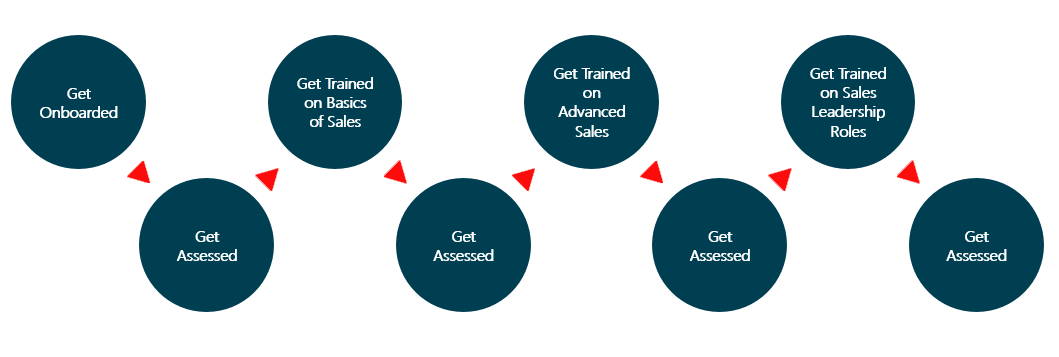Every year, countless blogs try and predict the eLearning trends for the oncoming period. And so, we decided to do something different. This article looks at 6 eLearning trends and features already present for commercial use, while also being easily accessible to everyone. However, the tools and features mentioned on this list have either not been:
- Utilized to its fullest
- Truly understood
- Discovered by some people
In this article, we discuss 6 eLearning trends and features that have existed for a while, but it’s their use in 2019 that will make a difference.
On this Page
Here are the top 6 eLearning trends and features for 2019
- AR/VR
- Micro Video-Based Courses
- Social Learning
- Learning Paths
- Blended Learning
- Content Curation
AR/VR
AR/VR is here, and this year we expect it to take off in a big way. To start things off, Walmart is really showing everybody how promising AR/VR is, so much so that it invested in 19,000 devices which aid in the process of AR/VR based learning. It is a conscious effort to strengthen their training activities. And how is it helping? The aim is to train their retail staff in a multi-faceted manner.
With online sales eating into retail market shares, Walmart strategically took the decision of improving the way their stores looked and operated. Part of the makeover also includes the manner in which employees cater to customers. The idea is to attract buyers back to the retail format through the aid of an improved retail purchasing experience.
Evidently, training is paying off for Walmart. In 2018, they recorded $495 billion in overall net sales which is $9 billion more than 2017. It may not seem like much, but fact is that almost all other retail companies have reported a drop in sales. With the implementation of AR/VR, only time can tell what other levels of success Walmart will achieve. For now, however, this is definitely one technology to invest in.
AR/VR is definitely one tool all industries that need a multi-faceted training format must consider. Some other industries where this technology will make a big difference are:
- Medical and healthcare
- Precision manufacturing
- Aeronautics and space development
- Natural resource exploration
Micro Video-Based Courses
This feature or rather format of training is very self-explanatory. It is the process of taking a long/complex topic and turning it into small micro section videos that use graphics and images to explain the topic well.
But why is micro video-based training the future? The answer lies in the increasingly decreasing attention spans of modern learners towards which social media is one of the biggest contributors.
When talking about micro-videos, one cannot ignore social media’s hand in it. Almost 99% of the videos found on popular social media platforms like Facebook range from anywhere between 1-15 minutes. Even the articles on Facebook by popular third-party publications like Huffington post and The Wired are short 5-minute reads accompanied by a short video.
Short videos and bite-sized content has permanently changed the way modern people consume content. Micro video-based training is definitely the future of training.
Today, 68% of the news consumed is via social media. This is reported by HubSpot who are pioneers in the art of micro video-based training themselves. HubSpot has also taken the concept of micro-videos and used it as an effective marketing tool driving their sales.
Learning Path
If you thought that automation is only limited to a set of activities, then training and development can easily be added to that list. Learning path, in short, is the ability to automate your training activities via the use of an LMS. Basically, as HR and L&D professionals, you set a pre-defined path for all new employees in an organization.
It is simply setting a set of training milestones to achieve (based on the job role), which the learners complete/achieve as they move along in the company. An LMS with the learning path feature automatically prompts the learners to start a new course after each successful completion.
It allows HR and L&D to create a tight and structured path for an employee to follow. It also highlights a clear path for the employee to grow within an organization. Here is an example of a learning path created for sales employees of an organization.

A sales employee needs to simply follow this learning path in order to learn new skills and win the opportunity to get promoted.
Social Learning
Social learning once again is mankind’s attempt at matching human behaviour with the optimum method of training. Since 68% of the developed world consumes content online over social media, it is no surprise that they also learn a lot via interactions that happen online. Comment threads, discussion forums, replies, and chat boxes, all offer peer-to-peer transfer of knowledge in an informal manner.
Social learning is just the ability to do this within an organization. The only difference is the ability to carry it out in a controlled manner via the LMS while measuring and monitoring aspects of it.
The social learning feature is definitely something to invest in 2019. You can expect LMSes with the chat forum or the Ask the Expert feature that supports formal training to take place in an informal manner. Group discussion features like many commonly used messaging applications will also start making an appearance on LMSes.
LMS administrators are expected to take advantage of social learning since it involves a lot more employee/learner involvement when compared to regular online training.
Blended Learning
Blended learning is definitely going to be one the most utilized eLearning features of 2019. If you as an organization have not started yet, you should consider blending traditional and futuristic training.
But why does blending help? Classroom training activities require the learners to devote maximum amounts of time, efforts, and energy in order to understand a topic. However, classroom training can sometimes just not be avoided.
Classroom training activities can last for an entire working day of 8 hours. Learner attention spans can last from anywhere in between 45-50 minutes. Hence, 8-hour training sessions do not make sense. Instead, blending classroom training with traditional training is a logical option.
Blending allows learners to access the basics of a topic on an LMS before attending a classroom training session. This way, 8 hours of classroom training activity can also be shortened to 4 hours depending on how much of the training is basic. i.e.: the learner accesses 4 hours of basic training from home and 4 hours of complex training in a classroom.
This way, the learner’s precious attention span is very carefully utilized for only the most important topics.

Content Curation
Gone are the days where eLearning courses were the only content accessible on the LMS. 2019 brings along with it a new concept called—content curation!
What is content curation? Content curation can be defined as carefully selecting pieces of content that are relevant to a training subject and passing it through the LMS as complementary training material. i.e.: for a training activity like best HR practices, complementary content pieces are carefully selected from over the internet like videos, text documents, and PDFs. These pieces of content are then passed through the LMS in order to aid the learners.
Content curation activities also act as topic stimulants, and sometimes carefully curated supporting content could make more of an impact than the actual training course itself.
One of the biggest reasons why content curation should work is because modern learners may find this form of learning more appealing when combined with an actual eLearning course. It is again a form of supporting formal training through an informal method.
We are excited as anybody to see what eLearning trends and features 2019 brings with it. For now, our bets are on the 6 eLearning trends and features mentioned here!
If you want to know more about the eLearning trends and features shaping the various industries, subscribe to our blog post to stay updated.
Abara is a powerful and versatile system capable of handling your eLearning needs for 2019 with ease. Give Abara a try—click here to activate your 30-day free trial. You can also click here to request a demo to go along with your free trial, this way you can make the best of the Abara experience.


